Keywords
|
| Hybrid Power Filter, Total Harmonic Distortion, Active Power Filter, Point of Common Coupling. |
INTRODUCTION
|
| New topologies for harmonic mitigation and active filters have come a long way, and these address the line-harmonic control at the source. These mitigate some of the disadvantages of passive filters, however, for nonlinear loads above 1MW the passive filters are an economical choice. Practical and economical implementation of passive filter design, provided with required safeguards in most distribution systems is discussed. A comprehensive review of active filter (AF) configurations, control strategies, selection of components, other related economic and technical considerations, and their selection for specific application. Some active power filter (APF) methods have been developed to suppress the harmonics generated by these loads. A control technique in which voltage is generated proportional to the source current harmonics by this series and parallel resonances are eliminated. The control approach of detecting source current in terms of the basic operation principle of a series APF, then developing a control approach of detecting load voltage and in this approach, the reference signal of the compensation voltage needed by the series APF is obtained by detecting both source current and load voltage. |
| A novel control scheme compensating for source voltage unbalance and current harmonics in series-type active power filter systems combined with shunt passive filters is proposed, which focuses on reducing the delay time effect required to generate the reference voltage. Using digital all-pass filters, the positive voltage sequence component out of the unbalanced source voltage is derived. The instantaneous reactive power defined from a cross product. |
| In this paper a new control strategy based on the dual formulation of the electric power vectorial theory and is proposed. For this, a balanced and resistive load is considered as reference load. This strategy obtains the voltage that the active filter has to generate to attain the objective of achieving ideal behavior for the set hybrid filter-load. When the source voltages are sinusoidal and balanced the power factor is unity, in other words, the load reactive power is compensated and the source current harmonics are eliminated. This means, it is possible to improve the passive filter compensation characteristics without depending on the system impedance. It also avoids the danger that the passive filter behaves as a harmonic drain of close loads, and likewise, the risk of possible series and/or parallel resonances with the rest of the system. In addition, the compensation is also possible with variable loads without detuning passive filter. |
| The application of proposed method is also extended by creating LG /LL faults at the source side for nonlinear balanced loads. The shunt passive and series active filters works effectively to compensate the source currents by injecting compensating currents at the point of common coupling under the application of LG/LL faults at the source side. |
| Conventionally, a passive LC power filter has been used to attenuate the harmonic currents generated by nonlinear loads due to their low cost and high efficiency. However, they have some drawbacks-Susceptible to series and/ parallel resonances, their compensation characteristics heavily depend on system impedance because in order to eliminate source current harmonics the filter impedance has to be smaller than the source impedance. These are not suitable for variable loads, since variation of the load impedance can detune the filter and also they are designed for a specific reactive power and there is a danger that the passive filter behaves as a harmonic drain of close loads due to circulation of harmonic coming from nonlinear loads connected near the connection point of passive filter. |
| Some active power filter (APF) methods have been developed to suppress the harmonics generated by these loads. An active power filter typically consists of a three-phase pulse width modulation (PWM) voltage source inverter is connected in series to the ac source impedance [1-3]. This equipment improves the compensation characteristics of the passive filter in parallel connection. Fig.1 shows the system topology, where vc is the voltage that the active filter should generate to achieve the objective of control method. |
| For this configuration, several techniques had been applied to obtain the control signal for the active filter which is connected in series with the load. Most used control target is that provides high impedance for harmonics while providing zero impedance for fundamental harmonics. This strategy is achieved when active filter generates a voltage proportional to the source current harmonics. Elimination of series and/or parallel resonances with the rest of the system is possible with this control strategy. The active filter will avoid the passive filter becoming harmonic drain of close loads. Besides it can prevent the compensation features from dependence on the system impedance. In other proposed control technique, a voltage waveform generated by the APF is similar to the voltage harmonics at load side but in opposition. This strategy only prevents the shunt passive filter depending on the source impedance, the limitation of the passive filter nevertheless remain. To improve the compensation characteristics of the passive filter, another control strategy combining both the aforementioned strategies is proposed, but they continue to suffer from the difficulty of finding an appropriate value for the APF gain k. |
| Finally, another control approach has recently been proposed which suggests that the active filter generates a voltage that is used to compensate the passive filter and load reactive power, also to eliminate current harmonics. Here the calculation algorithm is based on the instantaneous reactive power theory. There, the control target is to achieve constant power in the source side. |
| All the strategies presented above are applied to three-phase three-wire system with balanced loads. In this a new control strategy based on dual formulation of instantaneous reactive power vectorial theory is proposed. It applied by considering a balanced and resistive load as ideal load. Thus the determined reference voltage generated by the active filter is obtained which is used to attain the objective of achieving ideal behaviour for the set hybrid filter-load. The instantaneous reactive power here is defined from a dot product where as it is defined as a cross product. The final development allows any compensation strategy to be obtained, among them, unit power factor. The application of proposed method is also extended by creating LG /LL faults at the source side for nonlinear balanced loads. The shunt passive and series active filters works effectively to compensate the source currents by injecting compensating currents at the point of common coupling under the application of LG/LL faults at the source side. |
CONTROL STRATEGY FOR THREE-PHASE HYBRID POWER FILTER
|
| A new control strategy for simulation of three phase hybrid power filter for power quality improvement is proposed. This filter consists of shunt passive LC power filter and series active filter. A new control method based on dual formulation of instantaneous reactive power vectorial theory is proposed. It is applied by considering a balanced and resistive load as reference load, so that the voltage waveform injected by the active filter is able to attain the objective of achieving reactive power compensation, also helps in eliminating load current harmonics and to balance asymmetrical loads [4]. By this control strategy the behaviour of the passive filter is improved. |
| The presence of harmonics in the power electrical systems is the main cause of the electrical wave pollution that so many problems carry. The indiscriminate increase of non-linear loads has given rise to investigation into new compensation equipment based on power electronics. The main design target for this equipment is the elimination of the harmonic present in the system and a reduction in the power reactive. Depending on the application type, series or parallel configurations or combinations of active and passive filters have been proposed |
| When the objective is to compensate current-source nonlinear loads, named harmonic current source (HCS), a shunt configuration as compensation equipment is used. To eliminate harmonics in this kind of load, a shunt passive filter have traditionally been used, mainly due to their low cost and minimal maintenance requirements. This compensation equipment has some drawbacks. An active power filter, APF, typically consists of a three-phase pulse width modulation (PWM) voltage source inverter is connected in series to the ac source is possible to improve the compensation characteristics of the passive filters in parallel connection. This topology is shown in Fig.1, where the active filter is represented by a controlled source, where vc is the voltage that the inverter should generate to achieve the objective of the proposed control algorithm. |
| Different techniques have been applied to obtain a control signal for active filter. In this thesis a new control strategy based on the dual formulation of electric power vectorial theory is proposed. For this a balanced and resistive load is considered as reference load. By this the compensation characteristics are improved. |
THE DUAL INSTANTANEOUS REACTIVE POWER THEORY
|
| It is mainly applied to compensation equipment in parallel connection. This theory is based on a Clarke coordinate transformation from phase coordinates (see fig.1 b). |
| In a three-phase system the voltage and current vectors can be defined by |
 |
| The vector transformations from the phase reference system a-b-c to α-β-0 coordinates can be obtained, thus |
 |
 |
| The instantaneous real power in the α-β-0 frame is calculated as: |
 |
| This power can be expressed as |
 |
 |
| Where p is the instantaneous real power without zero sequence components, this power can be written in vectorial form by means of dot product as |
 |
| Where transposed current vector in α-β is coordinates |
 |
| And is the voltage vector in the same coordinates |
 |
 |
| In a three-wire system the zero sequence real instantaneous power is null since there is no zero-sequence current components, that is, ??0=0. In such case, only the instantaneous power defined on the α-β axis exists, because the product v0 i0 is always zero. |
| The imaginary instantaneous power is defined by the equation |
 |
 |
| Both power variables previously defined can be expressed as |
 |
| The voltage vector can be decomposed in its orthogonal projection on the axis defined by the current vectors and, in the αβ plane. By means of the current vectors and the real and imaginary instantaneous power, the voltage can be calculated as: |
 |
COMPENSATION STRATEGY
|
| Electrical companies try to generate electrical power with sinusoidal and balanced voltages and it has been obtained as reference condition in the supply. Due to this fact, the compensation target is based on an ideal reference load, which must be resistive, balanced, and linear [5-8]. It means that the source currents are collinear to the supply voltages and the system will have unity power factor. Therefore, at the point of common coupling (PCC), the following expression will be satisfied: |
 |
| Here, Re is the equivalent resistance, v is the voltage vector on the connection point, and i the supply current vector. The average power supplied by the source will be |
 |
| Compensator instantaneous power is the difference between the total real instantaneous power required by the load and the instantaneous power supplied by the source i.e., considering the average values |
 |
 |
 |
| Therefore the equivalent resistance can be calculated as |
 |
| where is the load average power defined as |
 |
| Fig. 2 shows the system with series active filter, parallel passive filter and unbalanced and non-sinusoidal load. The aim is that the set compensation equipment and load has an ideal behaviour from the PCC. The voltage at the active filter connection point in coordinates can be calculated as follows: |
 |
| In this equation, the restriction of null average power exchanged by the active filter is imposed. The load voltage is given according to (15) by |
 |
| where is the real instantaneous power and is the load imaginary instantaneous power. The reference signal for the output voltage of the active filter is |
 |
| Considering (22) and (23), the compensation voltage is |
 |
| When the active filter supplies this compensation voltage, the set load and compensation equipment behaves as a resistor . Finally, if currents are unbalanced and non-sinusoidal, a balanced resistive load is considered as ideal reference load. Therefore, the equivalent resistance must be defined by the equation |
 |
| Here,1 +2 is the square rms value of the positive sequence fundamental component. In this case, (24) is modified, where 1 is replaced by 1 + , that is |
 |
| Reference signals are obtained by means of the reference calculator shown in Fig. 3 a) and b). In the case of unbalanced loads, the block ?fundamental component calculation? in Fig. a is replaced by the scheme shown in Fig. b, which calculates the current positive sequence fundamental component in case of unbalanced loads [9-12]. |
| However, a modification in the control scheme of Fig. 3 a) is necessary. This consists in including a third input signal from the zero sequence power p0 in the control block where is generated. The proposed control strategy may be suitable in a stiff feeder, where voltage could be considered undistorted. |
| The proposed control strategy is extended by creating LG /LL faults at the source side. The series active power filter and shunt passive filter works effectively to compensate the source currents by injecting compensating currents at the point of common coupling under the application of LG/LL faults at the source side |
SIMULATION RESULTS AND ANALYSIS
|
| The system shown in Fig.4 has been simulated in the Matlab-Simulink platform to verify the proposed control. Each power device has been modeled using the Sim Power System toolbox library. The power circuit is a three-phase system supplied by a sinusoidal balanced three-phase 100-V source with a source inductance of 5.8mH and a source resistance of 3.6 Ω. The inverter consists of an Insulated Gate Bipolar Transistor (IGBT) bridge. On the dc side, two 100-V dc sources are connected. An LC filter has been included to eliminate the high frequency components at the output of the inverter. This set is connected to the power system by means of three single-phase transformers with a turn ratio of 1:1. |
| The passive filter is constituted by two LC branches tuned to the fifth and seventh harmonics. The selection criteria to fix the ripple filter were, in the case of low frequency components, that the inverter output voltage be almost equal to voltage across Crf. However, in the case of high-frequency components, the reduced voltage in must be higher than in the capacitor Crf. Furthermore, Lrf and Crf values must be selected so as not to exceed the transformer burden. |
| Therefore, the following design criteria must be satisfied. |
| to ensure that inverter output voltage drops across at the switching frequency; |
| to ensure that voltage divider is between Lrf and Crf, where is the source impedance, |
| the shunt passive filter, reflected by the secondary winding. |
| At 20-kHz switching frequency, ZS=728 Ω ZF=565 Ω,XCRF =0.16 Ω XLRF=1696 Ω. |
| Two load types were simulated: |
| —nonlinear balanced load; |
| —nonlinear unbalanced load |
SIMULATION IMPLEMENTATION AND ANALYSIS FOR NONLINEAR BALANCED LOAD
|
| In this case, the nonlinear load consists of an uncontrolled three-phase rectifier with an inductance of 55 mH and a 25 Ω resistor connected in series on the dc side. |
| In this case the total harmonic distortion is very high and hence the system is compensated to reduce total harmonic distortion. |
| The passive filter was designed only to compensate the source current harmonics; the reactive power was not considered. To get the source current without distortion an active filter is connected in series with the load along with parallel passive filter. The passive filter is connected along with active filter inorder to reduce internal harmonics generated by the active filter. By means of a calculation block, e vectors in αβ coordinates can be determined. |
| The product of these vectors allows the instantaneous real power to be calculated, obtaining its average value with a low-pass filter (LPF). This is the power required by the set passive filter and load. |
| The fundamental component is obtained by means of a block with the scheme shown in Fig.7. Each component of the source current vector is multiplied by sinwt and coswt where w is the fundamental frequency in rad/s. The average values of the results are obtained using two low-pass filters. They are multiplied by sinwt and coswt again and then by 2. |
| This allows the current vector fundamental component to be obtained; conversely, the real instantaneous power is divided by The result is multiplied by the current vector, which allows the first term in the compensation voltage in (25) to be determined. On the other hand, the imaginary instantaneous power is obtained and divided by and finally multiplied by the current vector. This determines the second term in the compensation voltage (25). The simulation blocks for series active and shunt passive filter allows the proposed control to be verified, the passive filter compensation characteristic to be improved and unity power factor is practically achieved. |
| The passive filter impedance has to be lower than the system impedance in order to be effective. When the branch LC or impedance source quality factor is low, the harmonics filtering deteriorates. To verify the behavior of the compensation equipment in this situation, the source impedance is modified. It is changed from 3.6 Ω and 5.8mH to 1.3 Ω and 2.34mH. In a distribution system, variations may appear in the load power. To verify the behavior of the proposed control strategy, the resistor value connected at the dc side of the uncontrolled three-phase rectifier was changed from 25 Ω to 50Ω. The source impedance is 3.6Ω and 5.8mH. Therefore, with the proposed control algorithm, the set active filter and passive filter allow the compensation of variable loads [12-15]. This proposed control algorithm helps in reactive power compensation and can improve the compensation characteristics of the passive filter. Hence by the proposed control algorithm the behavior of the passive filter is improved. |
SIMULATION RESULTS FOR NONLINEAR BALANCED LOADS
|
| The fig.9 (a) shows the phase load current waveform. The load current total harmonics distortion (THD) is 19.02%, when the system is not compensated. The 5th and 7th harmonics are the most important in the current waveform. They are 16.5% and 8.9% of the fundamental harmonic, respectively. |
| The source current waveform with the passive filter connected is shown in Fig.9 (b). The THD falls from 19.02 to 3.23% and the 5th and 7th harmonics decrease to 2.4% and 0.8%, respectively. The source current waveform when only active filter is shown in fig.9 (c). Fig.9 (d) shows the source current waveform when both active and passive filters are connected. When the active filter is connected, the source current THD falls from 3.23% to 1.30%. The source current has a THD of 6.02%, when the active filter is not connected and the compensation equipment is only the passive filter when source impedance is changed from 3.6 Ω and 5.8mH to 1.3 Ω and 2.34mH. The source current waveform is shown in Fig.9 (e). The 5th and 7th harmonics are 8.4% and 2.6% of the fundamental harmonic and the power factor is 0.97. Fig.9 (f) shows the source current waveform when the active filter is working with the proposed control strategy and shows the THD of the source current improves from 6.02% to 1.52%. |
| When the passive filter is connected, the source current waveform is shown in the Fig.9 (g), which has a THD of 3.63% in the case the resistor value connected at the dc side of the uncontrolled three-phase rectifier was changed from 25 Ω to 50Ω. The source impedance is 3.6Ω and 5.8mH, In this case, the power factor is 0.91. With the active filter connected the source current has the waveform shown in Fig.9 (h). The THD falls from 3.63% to 1.36%. Total harmonic distortion (THD) for source current for variation in source impedance and dc side resistor is explained in table 4 and table 5. |
SIMULATION IMPLEMENTATION AND ANALYSIS FOR NONLINEAR UNBALANCED LOAD
|
| In this case, the three-phase load is built with three single-phase uncontrolled rectifiers with capacitors and resistors connected in parallel at the dc side with the values shown in Table 3. The simulation block diagram for nonlinear unbalanced load is shown in fig.10 which is not compensated. |
| The control scheme for the active filter is modified for unbalanced loads. The block ?fundamental component calculation? is replaced by another control scheme. Now the average power P is divided by the square rms value of positive sequence fundamental component. In this case, the positive sequence component is calculated by means of the block ?positive sequence component?, where the operator necessary to implement the Fortes cue transformation is obtained with an all pass filter. Subsequently, its fundamental value is calculated and the Fortes cue inverse transformation applied. fig. 11 shows the simulation block diagram for nonlinear unbalanced load with passive and with both active and passive filters. When the voltage is sinusoidal and balanced, a sinusoidal and balanced source current is obtained. When the voltage is distorted, unity power factor is achieved, although the source current is distorted. |
SIMULATION RESULTS FOR NONLINEAR UNBALANCED LOADS
|
| The system presents a behavior similar to a resistive and balanced load. The source currents THD are 1.47%, 1.09%, and 1.26% in phases and . Fig. 12 (c) shows the three source currents when this control is applied to the active filter. The system improves the behavior passive filter. The source currents THD are1.31 %, 0.99%, and 1.23% in phases and C.. |
| The proposed control algorithm can also be extended by creating LG /LL faults at the source side. The shunt passive and series active filters works effectively to compensate the source currents by injecting compensating currents at the point of common coupling under the application of LG/LL faults at the source side. Simulation block diagram for LL/LG fault without filters is shown in fig.13 (a). Simulation block diagram for LL/LG fault with filters is shown in fig.13 (b). |
| Hence with the proposed control strategy, though the faults are created both the active power filter and the passive filter works effectively. Both the shunt passive and series active filters works effectively and compensates the source currents by injecting compensating currents at the point of common coupling under the application of LG/LL faults at the source side. |
CONCLUSION
|
| Hence a control strategy for a hybrid power filter constituted by a series active filter and a passive filter connected in parallel with the load is proposed. The control strategy is based on the dual vectorial theory of electric power. The new control approach achieves the following targets. Suitable for variable loads as the reactive power variation is compensated by the active filter. Therefore, with the proposed control strategy, the active filter improves the harmonic compensation features of passive filter and reactive power is compensated. Also the currents harmonics are eliminated. Simulations with the MATLAB-Simulink platform were performed with different loads and with variation in the source impedance. The proposed technique can also be extended by creating LG /LL faults at the source side. The shunt passive and series active filters works effectively to compensate the source currents by injecting compensating currents at the point of common coupling under the application of LG/LL faults at the source side. |
Tables at a glance
|
 |
 |
 |
| Table 1 |
Table 2 |
Table 3 |
 |
 |
 |
| Table 4 |
Table 5 |
Table 6 |
|
| |
Figures at a glance
|
 |
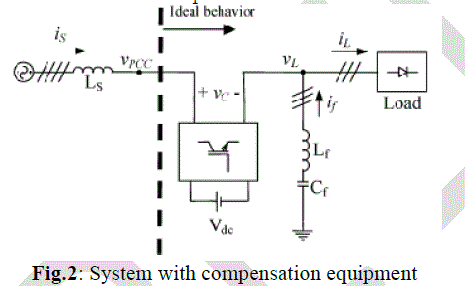 |
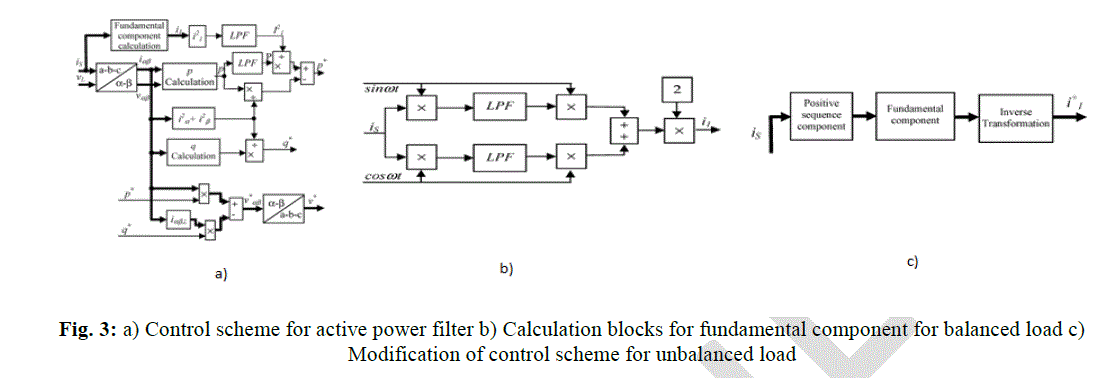 |
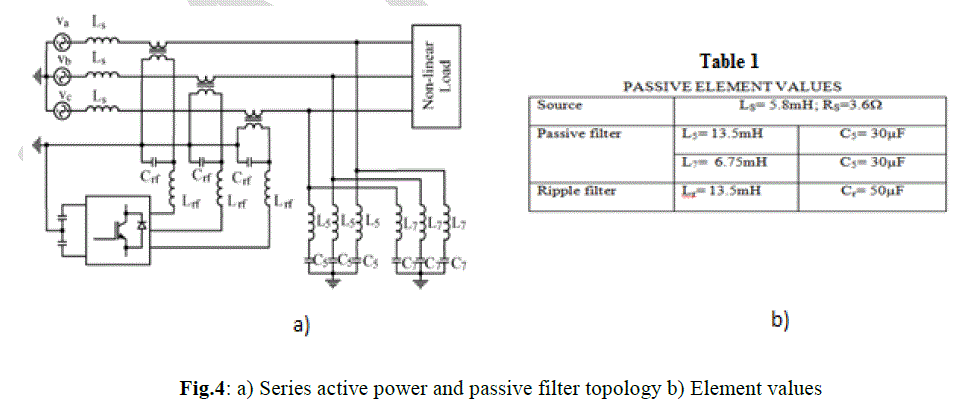 |
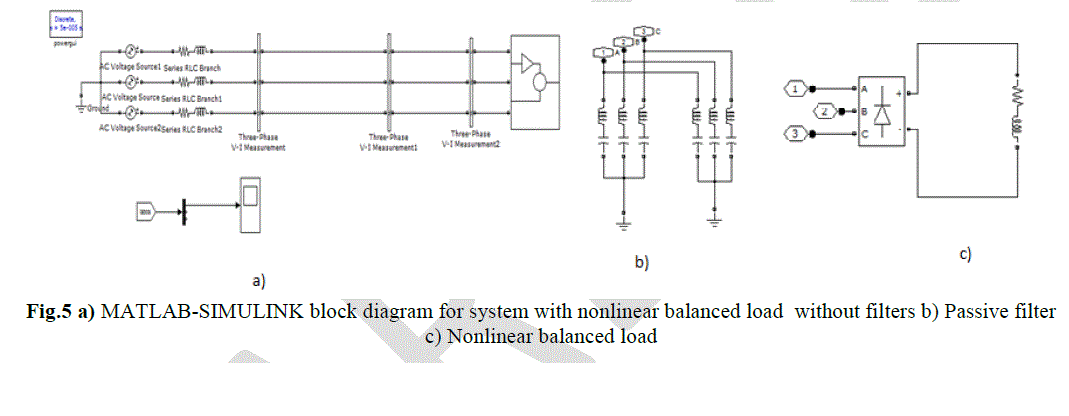 |
| Figure 1 |
Figure 2 |
Figure 3 |
Figure 4 |
Figure 5 |
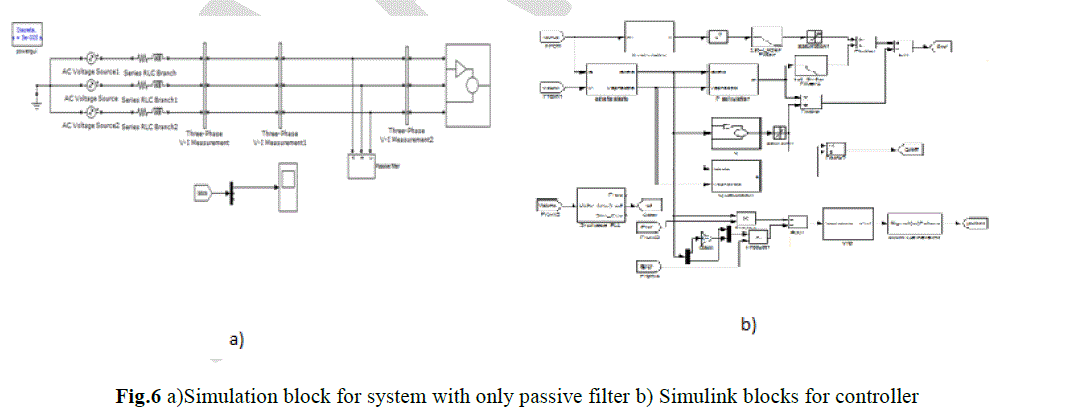 |
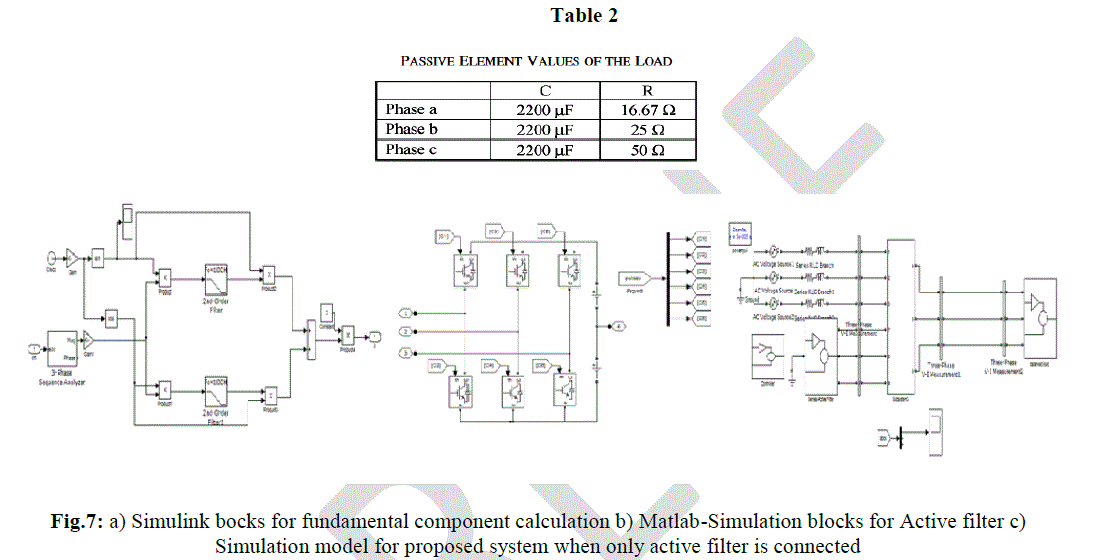 |
 |
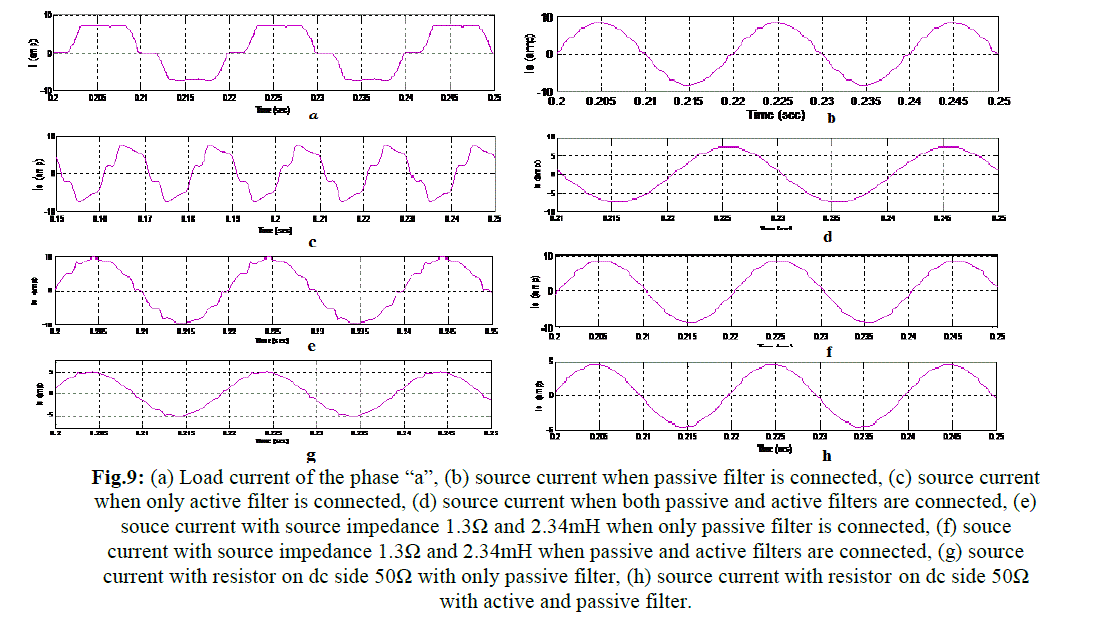 |
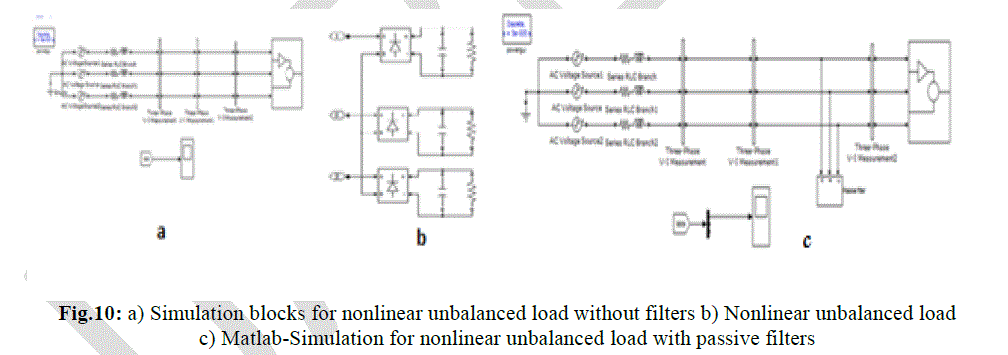 |
| Figure 6 |
Figure 7 |
Figure 8 |
Figure 9 |
Figure 10 |
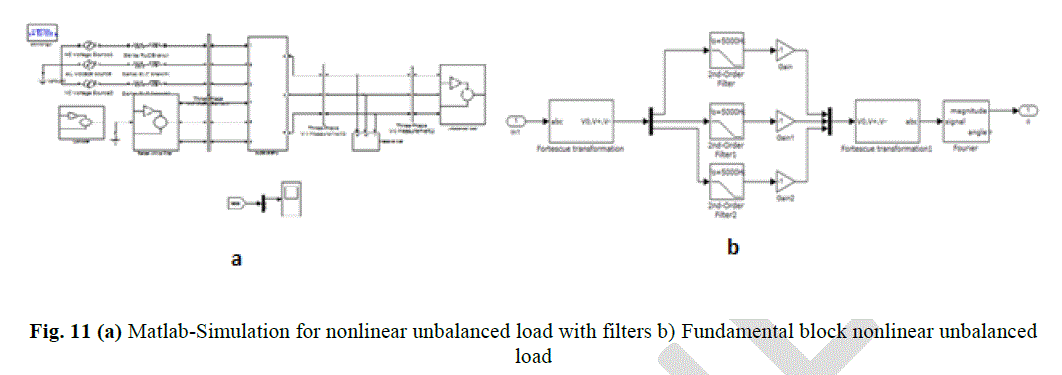 |
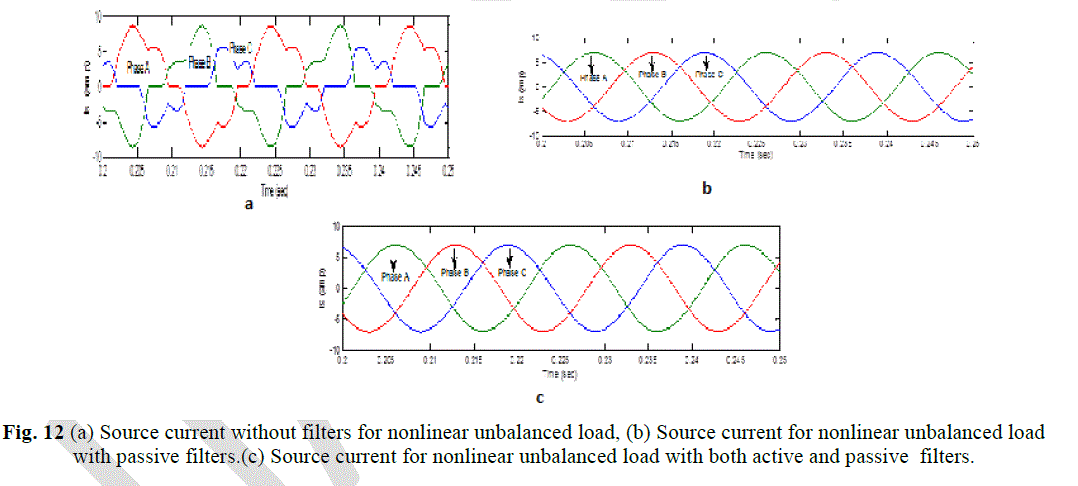 |
 |
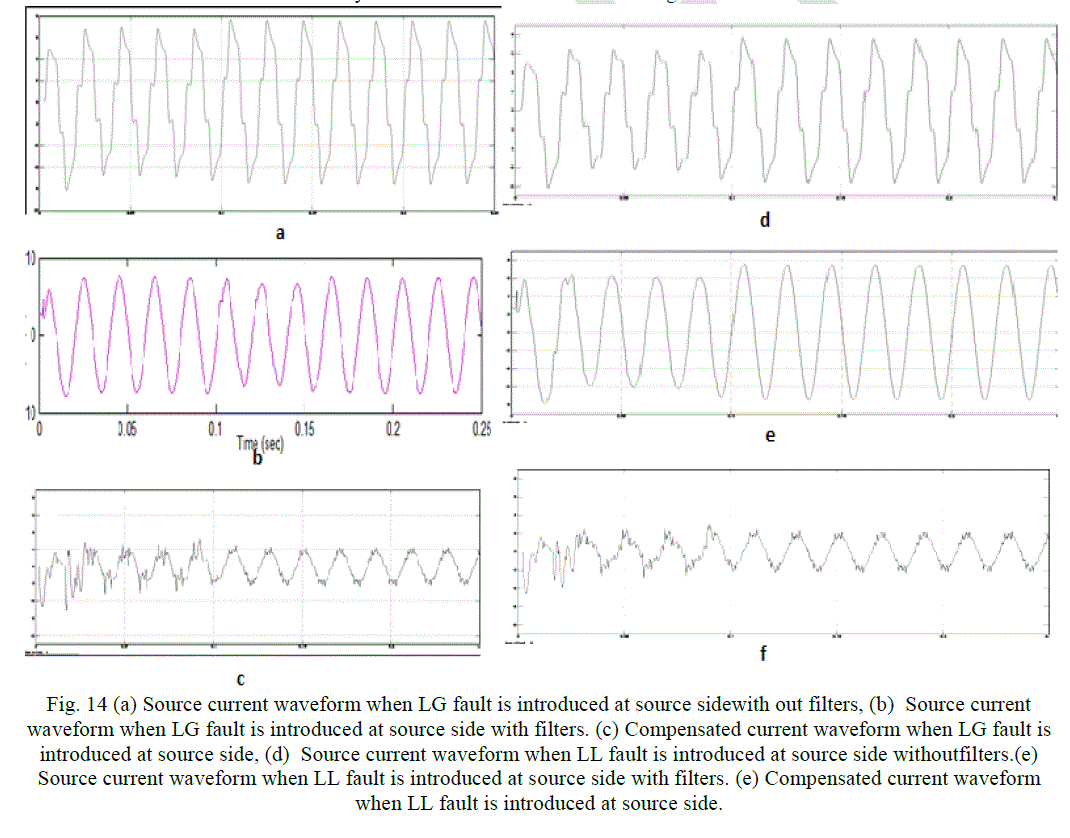 |
| Figure 11 |
Figure 12 |
Figure 13 |
Figure 14 |
|
| |
References
|
- P. Salmeron and S. P. Litran, ?Improvement of the electric power quality using series active and shunt passive filters,? IEEE Trans.Power Del., vol. 25, no. 2, pp. 1058–1067, 2010.
- J. C. Das, ?Passive filters-potentialities and limitations,?IEEE Trans.Ind. Appli., vol. 40, no.1, pp. 232–241, 2004.
- H. L. Ginn, III and L. S. Czarnecki, ?An optimization based method for selection of resonant harmonic filter branch para meters,?IEEE Trans.Power Del., vol. 21, no. 3, pp. 1445–1451,2006.
- J. A. Pomilio and S. M. Deckmann, ?Characterization and compensation of harmonics and reactive power of residential and commercial loads,?IEEE Trans. Power Del., vol. 22, no. 2, pp.1049–1055, 2007.
- H. Akagi, ?Active harmonic filters,?Proc. IEEE, vol. 93, no. 12, pp. 2128–2141, 2005.
- B. Singh, K. Al-Haddad, and A. Chandra, ?A review of active filters for power quality improvement,?IEEE Trans. Ind. Electron., vol. 46, no. 5, pp. 960–971, 1999.
- M. Rastogi, N. Mohan, and A. A. Edris, ?Hybrid-active filtering of harmonic currents in power systems,?IEEE Trans. Power Del., vol. 10, no.4, pp. 1994–2000, 1995.
- J. W. Dixon, G. Venegas, and L. A. Moran, ?A series active power filter based on a sinusoidal current-controlled voltage-source inverter,?IEEE Trans. Ind. Electron., vol. 44, no. 5, pp. 612–620, 1997.
- S. George and V. Agarwal, ?Optimum control of selective and total harmonic distortion in current and voltage under nonsinusoidal conditions,? IEEE Trans. Power Del., vol. 23, no. 2, pp. 937–944, 2008.
- F. Z. Peng, H. Akagi, and A. Nabae, ?A novel harmonic power filter,? in Proc. IEEE/PESC, pp. 1151–1159, 1988.
- F. Z. Peng, H. Akagi, and A. Nabae, ?A new approach to harmonic compensation in power systems-a combined system of shunt passive and series active filters,? IEEE Trans. Ind. Appl., vol. 26, no. 6, pp. 983–990, 1990.
- Z. Wang, Q. Wang, W. Yao, and J. Liu, ?A series active power filter adopting hybrid control approach,? IEEE Trans. Power Electron., vol. 16, no. 3, pp. 301–310, 2001.
- G.-M. Lee, D.-C.Lee, and J.-K. Seok, ?Control of series active power filters compensating for source voltage unbalance and current harmonics,? IEEE Trans. Ind. Electron., vol. 51, no. 1, pp. 132–139, 2004.
- Y. S. Kim, J. S. Kim, and S. H. Ko, ?Three-phase three-wire series active power filter, which compensates for harmonics and reactive power,? IEE Proc. Electric.Power Applications, vol. 151, no. 3, pp. 276–282, 2004.
- F. Z. Peng and J. S. Lai, ?Generalized instantaneous reactive power theory for three phase power system,?IEEE Trans. Instrum. Meas., vol. 45, no. 1, pp. 293–297, 1996.
- R. S. Herrera and P. Salmerón, ?Instantaneous reactive power theory:A comparative evaluation of different formulations,? IEEE Trans. Power Del., vol. 22, no. 1, pp. 595–604, 2007.
|